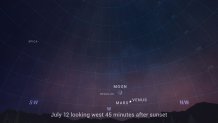Step outside Monday and Tuesday night and look to the west for a rare two-planet event that should be something special.
Frequent stargazers might already have noticed that Mars and Venus have appeared to get closer throughout July. On Monday night and into the early hours of Tuesday, the two planets will appear about a finger's width apart with the crescent moon hovering nearby.
It's an entire celestial neighborhood to take in.
“It’s a very special event,” said NASA’s Dr. Jim Garvin. “Our two neighbors, Venus and Mars, will appear in the same spot, just about on top of one another in the sky, right next to the crescent moon.”
Get top local stories in Southern California delivered to you every morning. Sign up for NBC LA's News Headlines newsletter.
Look to the western horizon just after sunset and you should see the crescent moon, bright shining Venus and the red dot of Mars.
The planets' closest approach will be Tuesday. The pair will only be about 4 degrees above the west-northwestern horizon as evening twilight ends.
Venus will continue to appear to shift to the left in the evenings to follow, moving away from Mars and toward the bright star Regulus.

In case you haven't noticed, Venus is so hot right now. NASA is preparing for two upcoming missions to our sister planet.
Local
Get Los Angeles's latest local news on crime, entertainment, weather, schools, COVID, cost of living and more. Here's your go-to source for today's LA news.
One will globally map the planet to better understand its shape and landscapes. Garvin is leading another mission called DAVINCI+, which stands for Deep Atmosphere Venus Investigation of Noble gases, Chemistry, and Imaging.
Basically, researchers want to study Venus’ atmosphere and find out what it’s made of, how it formed and how it evolved.
“This one-two punch, these two missions, will give us a new look on our lost frontier, our sister world Venus,” Garvin said.
The European Space Agency is eyeing another Venus mission in the 2030s.



